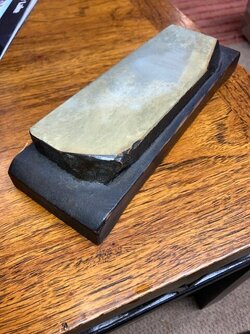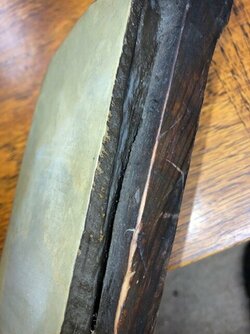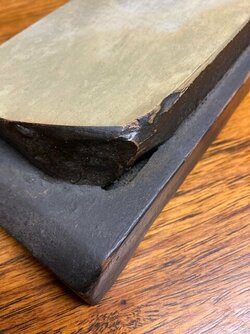I just purchased this vintage shohonyama tomae from hot_japan2016jp off of Ebay. Before I use it, I am concerned about getting water under the stone through these gaps, then getting nasty. It already has an old musty smell, I don't need it to get worse. I'm wondering if anyone has ideas if or how I should fill the gap? Epoxy? I could remove the base, but I like it. Not to mention it has a cool old patina.
You are using an out of date browser. It may not display this or other websites correctly.
You should upgrade or use an alternative browser.
You should upgrade or use an alternative browser.
Filling Space Between JNat and Base?
- Thread starter BanjoDadPDX
- Start date
Clear silicone caulk?
Silicon is common and works. I use blu-tack (poster putty). Solid hold, but removable.
The other (probably better) option is to seperate the stone and the base, and just use the base to steady the stone when honing. Then, after use you can take the stone off the base to allow both to dry properly.
Steve56
Ask me about shaving naked!
First thing, is it a fitted base or is the stone adhered to a flat base?
Looks kind of like there is a hollow under the stone in the pics.First thing, is it a fitted base or is the stone adhered to a flat base?
Agree with Steve. You need more info.
Is there glue/cement? Is there built up old slurry?
I use water and an old toothbrush to clean around. Then you can see what you have.
If the stone is glued to the base be very careful. It's a sedimentary rock and it can split if you force it.
So clean first and take more pics.
Is there glue/cement? Is there built up old slurry?
I use water and an old toothbrush to clean around. Then you can see what you have.
If the stone is glued to the base be very careful. It's a sedimentary rock and it can split if you force it.
So clean first and take more pics.
- Thread starter
- #8
It is adhered. Been stuck together for awhile. There is a decent sized cavity under the stone, which has a buildup of dust and funk. It's ancient, so I don't know. Separate or seal it - that seems to be the decision. It was used in a Japanese barbershop, supposedly.
Steve56
Ask me about shaving naked!
If it is adhered to a base, it’s probably because the stone won’t sit flat on a surface, it probably wobbles. Of course I don’t have it in hand. I’d clean out the gap and seal it with silicone sealant. Be tidy, less is more.
I have way less experience than the others here but it has happened more than once to me that a stone in a fitted base appears to be glued in but is actually just stuck because the wood in the base has shrunk around the stone, or because the old slurry has formed an adhesive paste. Obviously if there is visible glue that is not the case but if there isn't I would clean out as best I can and then hone on it a few times to see if the wood gets more amenable to releasing the stone.
Steve56
Ask me about shaving naked!
You can usually tell if the base is fitted or not. When I get a fitted base in, the first thing that I do is remove it and clean it, since the bases tend to shrink upon arrival from Japan in East Tennessee. Why I don’t know, it’s ver humid here in summer, but the bases still shrink. I monitor them over several days and relieve the bases a little if they start getting tight.
I want to preserve the fitted bases because they are unique to Japan, at least the way that they are made there. Fitted bases are disposable items there because you can just go down to the village carpenter and have another one made. Not so here. Other than leveling the stone, the fitted wooden bases are probably intended to wick water away from the stone.
I want to preserve the fitted bases because they are unique to Japan, at least the way that they are made there. Fitted bases are disposable items there because you can just go down to the village carpenter and have another one made. Not so here. Other than leveling the stone, the fitted wooden bases are probably intended to wick water away from the stone.
Does "relieving" simply mean lightly sanding or gently chiseling back the fitted cutout where it is tight against the stone?You can usually tell if the base is fitted or not. When I get a fitted base in, the first thing that I do is remove it and clean it, since the bases tend to shrink upon arrival from Japan in East Tennessee. Why I don’t know, it’s ver humid here in summer, but the bases still shrink. I monitor them over several days and relieve the bases a little if they start getting tight.
I want to preserve the fitted bases because they are unique to Japan, at least the way that they are made there. Fitted bases are disposable items there because you can just go down to the village carpenter and have another one made. Not so here. Other than leveling the stone, the fitted wooden bases are probably intended to wick water away from the stone.
Steve56
Ask me about shaving naked!
Usually relieving the base with a coping blade on the side and end.
- Thread starter
- #14
Usually relieving the base with a coping blade on the side and end.
Steve56
Ask me about shaving naked!
No, enlarging the sides of the stone relief in the base with a blade, like a sheepsfoot blade on a pocketknife, or a kiridashi.

Last edited:
Way too many internet sellers say their stones came from a barbershop. I would guess this one was a woodworkers stone. The base is very grungy and could use a refresh. If that assembly is legitimatelly 'ancient' then the glue used to mount the stone will come loose easily with some careful application of low heat. If it is more modern, and was epoxied in place, then things get difficult. It's easy to split shale so care must be used no matter what. I usually won't buy mounted stones for this reason. But I have separated many without issue using blow driers, an iron, solvents and once I popped the base off with a chisel. Not recommended
- Thread starter
- #17
Interesting. It doesn't smell like a barbershop. More like an engine repair shop. Old grease/oil? If they did use it as an oil stone, is it ok to use as a razor whetstone? Should I soak it in something?Way too many internet sellers say their stones came from a barbershop. I would guess this one was a woodworkers stone. The base is very grungy and could use a refresh. If that assembly is legitimatelly 'ancient' then the glue used to mount the stone will come loose easily with some careful application of low heat. If it is more modern, and was epoxied in place, then things get difficult. It's easy to split shale so care must be used no matter what. I usually won't buy mounted stones for this reason. But I have separated many without issue using blow driers, an iron, solvents and once I popped the base off with a chisel. Not recommended
First thing, is it a fitted base or is the stone adhered to a flat base?
- Thread starter
- #18
What is the danger of it being too tight? Wood split?You can usually tell if the base is fitted or not. When I get a fitted base in, the first thing that I do is remove it and clean it, since the bases tend to shrink upon arrival from Japan in East Tennessee. Why I don’t know, it’s ver humid here in summer, but the bases still shrink. I monitor them over several days and relieve the bases a little if they start getting tight.
I want to preserve the fitted bases because they are unique to Japan, at least the way that they are made there. Fitted bases are disposable items there because you can just go down to the village carpenter and have another one made. Not so here. Other than leveling the stone, the fitted wooden bases are probably intended to wick water away from the stone.
Here here, about the Japanese handcrafted mojo. Plus, the patina of the old thing is awesome. I just wish it didn't smell like diesel.
If it was used with oil you would see water bead up on it like rain on a waxed car. If that is the case, I wouldn't use it for razors at that point because oil can cause slurry to clump. Can it be done? Sure, anything can be done, it's just not something I would choose to do willingly. Besides how the stone was used, where it was stored and the conditions of storage matter tremendously.
I suspect that judicious use of warming heat would get the stone to release. If the adhesive is really obnoxios, a solvent can be used. Cutting into it should be a last resort really.
Because it appears to be covered in soot, and you don't know where it was stored, I'd avoid putting it in the oven.
A Dai keeps the stone up off the bench and keep the stone level. They don't wick water. Traditionally they are made mostly from Hiba, and purists will use Hinoki when available. Both woods are very water resistant, I've had a couple/few dozen new Dai here and either wood is just as good as the other IMO.
When/If a Dai is saturated with gunk, or oil, or whatever, and not fitted correctly, continued use can be problematic in that the stone can shift or the wood can twist. Rarely happens though. Usually, a problematic Dai was not cut correctly in the first place. Sometimes an adhesive causes issues. Other problems arise when any old paint is used to seal the stone and they muck up the base.
I suspect that judicious use of warming heat would get the stone to release. If the adhesive is really obnoxios, a solvent can be used. Cutting into it should be a last resort really.
Because it appears to be covered in soot, and you don't know where it was stored, I'd avoid putting it in the oven.
A Dai keeps the stone up off the bench and keep the stone level. They don't wick water. Traditionally they are made mostly from Hiba, and purists will use Hinoki when available. Both woods are very water resistant, I've had a couple/few dozen new Dai here and either wood is just as good as the other IMO.
When/If a Dai is saturated with gunk, or oil, or whatever, and not fitted correctly, continued use can be problematic in that the stone can shift or the wood can twist. Rarely happens though. Usually, a problematic Dai was not cut correctly in the first place. Sometimes an adhesive causes issues. Other problems arise when any old paint is used to seal the stone and they muck up the base.
What would you do in the case where a stone is sealed at a later time and becomes slightly thicker/ tighter fitting in the original fitted base. Would you slightly widen the fitted base or just leave it as it.If it was used with oil you would see water bead up on it like rain on a waxed car. If that is the case, I wouldn't use it for razors at that point because oil can cause slurry to clump. Can it be done? Sure, anything can be done, it's just not something I would choose to do willingly. Besides how the stone was used, where it was stored and the conditions of storage matter tremendously.
I suspect that judicious use of warming heat would get the stone to release. If the adhesive is really obnoxios, a solvent can be used. Cutting into it should be a last resort really.
Because it appears to be covered in soot, and you don't know where it was stored, I'd avoid putting it in the oven.
A Dai keeps the stone up off the bench and keep the stone level. They don't wick water. Traditionally they are made mostly from Hiba, and purists will use Hinoki when available. Both woods are very water resistant, I've had a couple/few dozen new Dai here and either wood is just as good as the other IMO.
When/If a Dai is saturated with gunk, or oil, or whatever, and not fitted correctly, continued use can be problematic in that the stone can shift or the wood can twist. Rarely happens though. Usually, a problematic Dai was not cut correctly in the first place. Sometimes an adhesive causes issues. Other problems arise when any old paint is used to seal the stone and they muck up the base.
Similar threads
- Replies
- 63
- Views
- 5K
- Replies
- 8
- Views
- 681
- Replies
- 4
- Views
- 275
- Replies
- 8
- Views
- 2K




